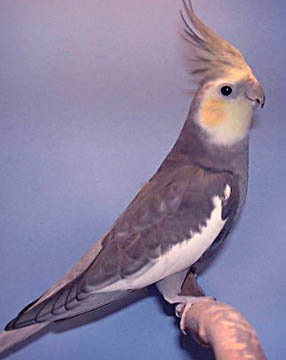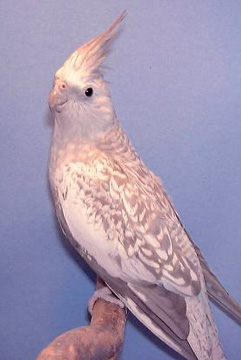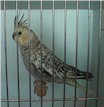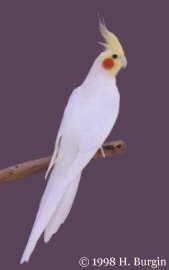|
||||||
|
||||||
| CALOPSITTE |
| Calopsitte: Colori |
| Calopsitte: FOTO mutazioni |
| Calopsitte: genetica |
| Calopsitte: fotografie |
| Links |
| Search by AltaVista |
Normal:Descriptions of Cockatiel Color MutationsClassifications
The normal grey should be of an even and uniform depth of color, free of marbling or lighter areas.
A consistency in overall tone is of more importance than depth of color. Birds sporting one or more yellow or white feathers on the head, nape, breast or other areas of the body (indicative of other color mutations in the recessive state) must be shown in the split class.Cinnamons:

A more pronounced brown shade (as when contrasted to normals) lacking any grey overtones, is preferred. A uniform depth of color, free from marbling (more common on the back and wings of some males due to a loss of melanin pigment) is desirable. Some hens may have more yellow (lipochrome pigment) on the face than their normal grey counterparts. All other markings to be judged as normals.Pearls:

"Lacings" should be extensive, uniform and well defined, with enough grey for contrast and free from splotching or defects in pattern. Hens should carry the pearl lacings over the back, wings, mantle and nape, with a heavier concentration on the shoulder. Yellow or white flecking on the breast is not unusual on heavier marked pearls. Adult pearl males who retain some degree of their lacings will be preferred. These lacings should be of a true pearl design, rather than the light spottings of normal males in the ticked class.Lutinos:

The lutino is a white bird with an orange cheek patch, some yellow pigment, pink feet and red eyes. Some individuals vary with a light to heavy yellow wash over part or most of the body. Baldness occuring behind the crest, as an inherited trait, will be penalized in accordance to its degree (or rewarded for its absence). Ideally, there should be no bald spot.Pied:

The primary factor when judging pieds will be the degree of symmetry and clarity of markings over the actual percentage of pied wash. Ideally, a desirable pied will carry a clear mask, free from extraneous grey feathers or "bleeding" from the orange cheek patch, clear tail and wing flights and a perfect balance of markings. All things being equal, a light pied with perfect symmetry of markings would be preferred to a heavier pied with more irregular markings.Albino (Lutino Whiteface):

A completely white bird with red eyes and pink feet, lacking the orange cheek patch and devoid of all pigment.Fallow:

A brownish (tan) appearance resembling the cinnamon, but with a more pronounced yellow suffusion and red eyes.Silver:

A "silvery grey" to brownish bird with black eyes on dominant and red eyes on the recessive silver. Color differs between European and American stock.Whiteface:

"Charcoal grey" in color, lacking the orange cheek patch and yellow pigment. The whiteface is devoid of all lipochrome pigment. Mature adult males will carry a white face as opposed to the yellow mask worn by other varieties.Cross Mutations:
--

Cross or triple mutations will be judged according to each color standard they represent, then as a combination of both (or all) mutations.Splits and Mutational Splits:
All split birds will be entered in the section they visually represent i.e., a normal split pied will be entered in the normal section; a cinnamon split pied will be entered in the cinnamon section, etc.
COLOR MUTATIONS
Descriptions of Cockatiel Color Mutations
- Normal Grey
- Cinnamon
- Lutino
- Fallow
- Slivers
- Whiteface
- Pearls
- Pied
- Whiteface Fallow
- Yellowface
- Albino
- Splits
[a cura di Alberto Masi]